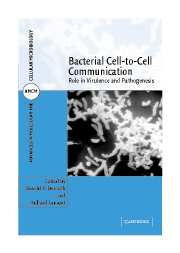
-
Select format
-
- Publisher:
- Cambridge University Press
- Publication date:
- August 2009
- February 2006
- ISBN:
- 9780511541506
- 9780521846387
- Dimensions:
- (228 x 152 mm)
- Weight & Pages:
- 0.663kg, 330 Pages
- Dimensions:
- Weight & Pages:
You may already have access via personal or institutional login
Book description
Many bacterial diseases are caused by organisms growing together as communities or biofilms. These microorganisms have the capacity to coordinately regulate specific sets of genes by sensing and communicating amongst themselves utilizing a variety of signals. This book examines the mechanisms of quorum sensing and cell-to-cell communication in bacteria and the roles that these processes play in regulating virulence, bacterial interactions with host tissues, and microbial development. Recent studies suggest that microbial cell-to-cell communication plays an important role in the pathogenesis of a variety of disease processes. Furthermore, some bacterial signal molecules may possess immunomodulatory activity. Thus, understanding the mechanisms and outcomes of bacterial cell-to-cell communication has important implications for appreciating host-pathogen interactions and ultimately may provide new targets for antimicrobial therapies that block or interfere with these communication networks.
Reviews
'This is an interesting book covering intercellular chemical signalling in diverse bacteria … The likely target audience for this book would be senior undergraduates and researchers for whom it would give a good contemporary introduction to signalling in different bacteria.'
George Salmond - University of Cambridge
Contents
Metrics
Full text views
Full text views help Loading metrics...
Loading metrics...
* Views captured on Cambridge Core between #date#. This data will be updated every 24 hours.
Usage data cannot currently be displayed.
Accessibility standard: Unknown
Why this information is here
This section outlines the accessibility features of this content - including support for screen readers, full keyboard navigation and high-contrast display options. This may not be relevant for you.
Accessibility Information
Accessibility compliance for the PDF of this book is currently unknown and may be updated in the future.


